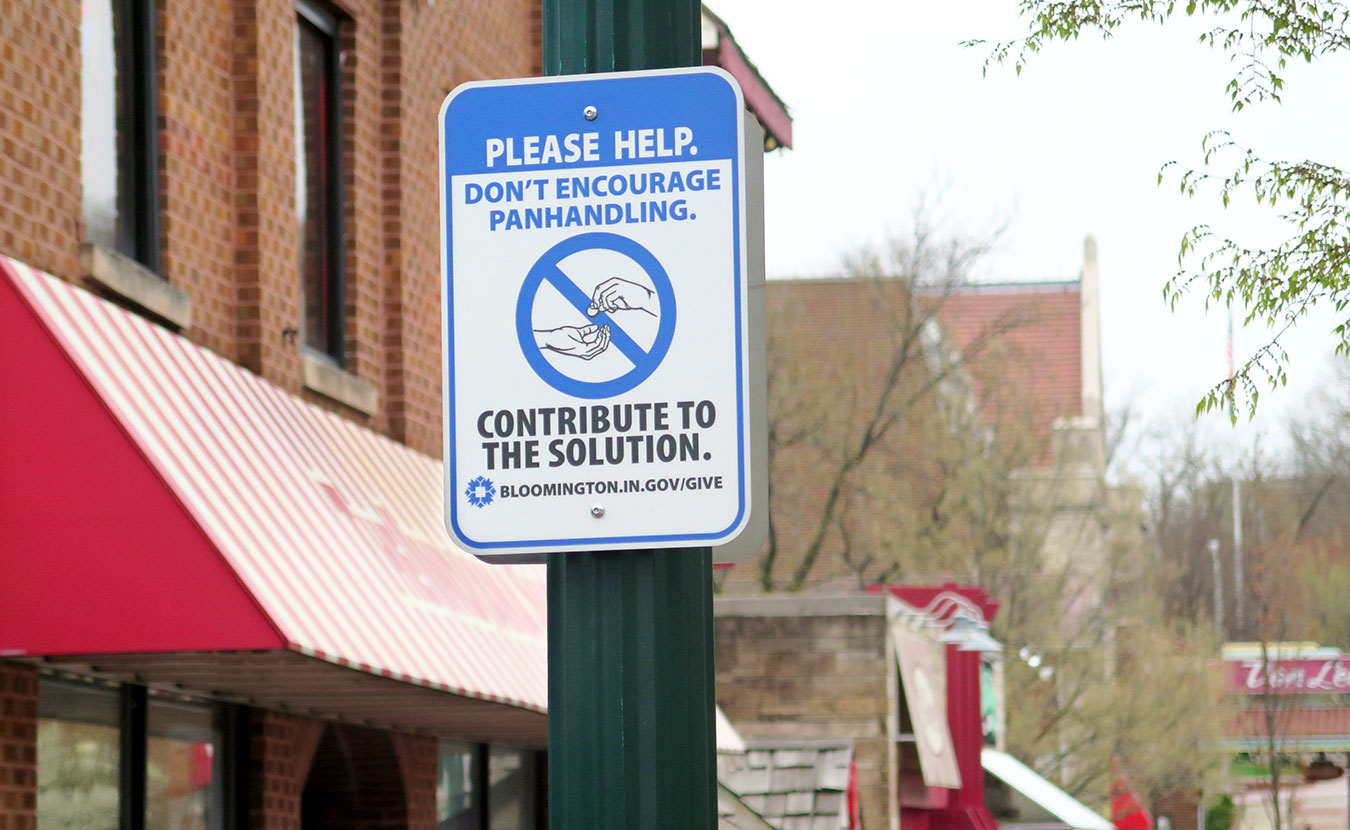Click here to read “Paths of Homelessness, Part 1: Your First Day.”
On a windy, near-freezing morning this past November, Chris Gabbard stepped off a Greyhound bus after buying a one-way ticket from Chicago to Bloomington. Living with short-term memory loss, the 34-year-old has been experiencing homelessness for the past 10 to 15 years — he can’t remember the exact number.
Gabbard was born in Chicago in what he describes as a rough neighborhood, but after being robbed, assaulted, abused, and taken advantage of too many times, he decided to skip town. He was trying to go to school to become an electrician, but he says his past experiences made him afraid to enroll in any Chicago schools.
“I’m really skittish, because when I was younger I got beat on a lot,” he says. “It makes me not trust people right away. I knew if I joined school in Chicago that I would get robbed again.”

Chris Gabbard has experienced chronic homelessness and has been using services at Shalom for the past few months since arriving in Bloomington. | Photo by TJ Jaeger
Since his mother was living in southern Indiana at the time, he chose Indiana as his new home state. However, his mother was apprehensive about his staying with her because he doesn’t get along with his sister.
While researching Indiana cities on the internet and through word of mouth, Bloomington caught Gabbard’s eye due to the number of social services available.
After arriving in Bloomington at the bus station on East 3rd Street, Gabbard walked on South Walnut a couple of blocks to the Shalom Community Center. He has been using their services for the past five months.
Forrest Gilmore, executive director of Shalom, describes people in Gabbard’s situation as “chronically homeless” — stuck in the vicious cycle of homelessness for the better part of their lives. Be it mental disorder, addiction, personal injury, or countless other reasons, individuals can slip into a path that is difficult to escape.
“There’s a saying that [chronically homeless people] represent 20 percent of the [homeless] population but need 80 percent of the services,” Gilmore says. “Without some kind of intervention, they generally die on the streets.”
And more often than not, these are the people — like Gabbard and his traumatic experiences in Chicago — who are being stigmatized by students, business owners, politicians, and other non-homeless citizens, Gilmore says.
Gilmore believes the homeless population commits severe crimes at a lower rate than the general population. “Chronically homeless people are actually far more likely to be a victim of a crime than to be the perpetrator,” he says, adding that the majority of crimes committed by those experiencing homelessness are “nuisance crimes” — including public intoxication, trespassing, petty theft, and disorderly conduct.
Because these crimes are public and bother people, Gilmore says the community often performs witch hunts on the homeless population.
This past September, an online petition was posted on Change.org that was originally titled “John Hamilton: Put an end to the homeless people in Peoples Park in Bloomington, Indiana.” The name was eventually changed to “Help find better care for the homeless people that isn’t Peoples Park in Bloomington” and has received nearly 700 signatures and a number of comments.
While many signers did express their concerns about getting the homeless population better help, plenty chose to complain about the inconveniences those who frequent Peoples Park cause the community.
One person wrote, “I feel scared walking past this park at night, and with as much tuition as I am paying (out of state) I deserve to feel safe.”
Another wrote, “These people terrorize kids on Kirkwood when it’s dark out.”
And still another commented, “They make me scared to get my Big Cheese and ice cream … and I like my Big Cheese and ice cream.”
Dwayne Gordon, the Bloomington-area director for Wheeler Mission Ministries, says there are legitimate concerns about drug abuse and violence in Peoples Park, but demonizing people doesn’t help.
“It is unfortunate, yes, but they’re still people,” he says. “And, honestly, I think most of them can be helped. I’ve seen it. I’ve seen people go from being hopeless and suicidal and completely addicted to becoming good participants in the community.”
Elaine Guinn, the executive director of the New Hope Family Shelter, says there is an embedded hypocrisy when looking at those in the homeless population living with addiction in comparison to the party-school mentality at Indiana University.
“The level of classism is rampant around here,” she says. “It’s okay for this college girl that’s 21 — and she’s going through a rite of passage — to be puking behind a bar. But if we see a man in his 50s — should he live that long — if he’s puking behind a bar, then that is just unacceptable, and he’s unsafe.”
Often, harassment of the homeless population by college students goes beyond saying harmful things on the internet.
Susan Grubb, a volunteer at Shalom who experienced homelessness all of last year, says there were times when college students would go out of their way to harass her.
“When the IU students go get drunk, some of them want to come pick on us,” she says. “They call us names and be mean to us. They think they’re better than us because their mommies got money. Sorry our parents weren’t rich and we didn’t make it to IU.”
Debra Morrow, the executive director at Middle Way House, says she heard about a man who slept on the street one night and woke up to find somebody had stapled a McDonald’s job application onto his clothes.
“When you look at statistics and see that so many people are just one paycheck away from homelessness, I think that fear makes people want to separate themselves that much more from the problem,” she says.
Gilmore agrees, and says the online petition, the verbal and physical harassment, anti-panhandling signs, and countless other tactics are often fueled by this fear of becoming homeless and the desire to sweep the problem under the rug.
In response, Gilmore spearheaded a housing-first program in 2013, which has been further helping alleviate Bloomington’s homeless epidemic.
“Over the last ten years, we’re actually seeing that number go down [in Bloomington], and that’s because we’re shifting toward a housing-first model,” he says. “If we want to end homelessness, ultimately we have to go for the most obvious solution: invest in housing and people’s ability to maintain their housing.”
Crawford I and Crawford II are programs designed to provide houses and apartments to those experiencing chronic homelessness who would otherwise never be able to afford and maintain a home.
The programs are designed to provide a home first and, with that stability, support these individuals and families and teach them how to maintain their homes. This includes assistance with cleaning, cooking, finances, job searches, and more.
“Getting someone into a home is difficult, but for some individuals, helping them stay in a home is the real challenge,” Gilmore says. “They have so many issues or struggles that actually helping them maintain their home is the real work.”
So far, the Crawford programs have boasted a 90 percent success rate and are housing dozens of individuals who had previously been chronically homeless, Gilmore says.
Along with the Crawford programs, New Hope, Middle Way, Wheeler, and others offer transitional housing programs, which go beyond the immediate overnight shelter model.

Crawford I provides apartments to those experiencing chronic homelessness who would otherwise never be able to afford and maintain a home. | Photo by TJ Jaeger
Despite the success of these multimillion-dollar, state-funded programs, Gilmore says more housing is required to solve Bloomington’s homeless epidemic.
“Our biggest challenge in this whole attempt to end homelessness is availability [of housing],” he says. “We know how to end homelessness, but our challenge as a community is not having enough resources to do that.”
Regardless of which programs Bloomington citizens prefer, Morrow says people can give back by volunteering, donating, and being an active, caring member of the community.
“I think everybody can be a small part of the solution,” she says. “Donate to those agencies who serve the homeless. Don’t be critical; don’t be judgmental. If there’s a problem, we’re all a part of it.”
Gabbard’s mother left for Texas right before he moved to Bloomington. She doesn’t do well with the cold weather, he says. If she moves back, Gabbard hopes she’ll let him move in with her, just until he comes up with a game plan.
For now, he wants to go to school at Ivy Tech Community College to become an electrician. Once he gets his contractor’s license from the city, he says he wants to start his own business. Because of his life experiences, he wants to use any expendable income to help people experiencing homelessness.
“I’d like to help the homeless people by getting them off the streets, feeding them, and donating gifts and money when I get a job,” he says.






No Replies to "Paths of Homelessness, Part 2: Demonizing the Less Fortunate"